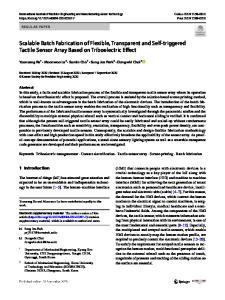Fabrication of carbon-nanotube-based sensor array and interference study
- PDF / 479,274 Bytes
- 7 Pages / 584.957 x 782.986 pts Page_size
- 22 Downloads / 366 Views
An array of 32 sensor elements with single-walled carbon nanotubes (SWCNTs) as the sensing medium has been fabricated. The microfabrication approach used allows reduction of the chip size and increases the number of sensor elements in a chip and is amenable for large wafer scale-up. The sensor array chip is designed as an electronic nose for use with the aid of a pattern recognition algorithm. The sensor chips were tested for NO2 sensing and interfering effects from humidity and a background of chlorine. The results indicate that NO2 can be detected at low concentration levels of 0.5 ppm in the presence of chlorine at 30 times higher concentrations. The sensor response is affected by humidity, which implies that the training data set for NO2 detection needs to be generated for multiple humidity levels for interpolation purposes during field use. I. INTRODUCTION
Gas or vapor chemical sensors find applications in chemical, agricultural, food processing, beverage, mining, security, and other industries.1–4 Reports on chemical sensing in the literature commonly include H2, CO, NH3, NO2, NO, O2, ozone, CH4, HCl, Cl2, SO2, and various volatile organic compounds. Commercially available chemical sensors are based on technologies, such as metal oxide thin film sensors, conductive polymer sensors, quartz crystal microbalance systems, surface acoustic wave sensors, etc.4 These technologies do not meet some or all of the desirable attributes in industrial chemical sensing: high sensitivity (parts per billion, ppb to parts per million, ppm depending on the application), room temperature operation, small size (mass, volume), low power consumption, rapid response and recovery, long term stability, amenable to mass production, and low cost. As a result, chemical sensor development continues to be an active area of research, currently utilizing advances in microfabrication, microelectromechanical systems, and nanomaterials. Nanotechnology may offer advantages with respect to some of the expectations above. Nanomaterials such as carbon nanotubes (CNTs) and inorganic nanowires5,6 exhibit a large surface to volume ratio, leading to large adsorption rates for various gases and vapors. This can sensitively change some property of the nanotube or nanowire, such as resistance, capacitance, or dielectric constant. The ability to measure and monitor the change in a)
Address all correspondence to this author. e-mail: [email protected] This paper has been selected as an Invited Feature Paper. DOI: 10.1557/jmr.2011.225 J. Mater. Res., Vol. 26, No. 16, Aug 28, 2011
http://journals.cambridge.org
Downloaded: 17 Mar 2015
one of these properties forms the basis for sensing with increased sensitivity and a decrease in power consumption (relative to the corresponding thin film-based sensors), in addition to the opportunity to reduce the size and weight. For example, single-walled carbon nanotubes (SWCNTs) have been characterized to possess a surface area as high as 1580 m2/g.7 Taking advantage of this, numerous reports have appeared on the investig
Data Loading...








